The Mallets of Invention: A listening guide to Frank Zappa’s percussionists
The Mallets of Invention: A listening guide to Frank Zappa’s percussionists
by Dr. Kyle Forsthoff and Dr. Michael Yonchak
Percussive Notes
Volume 62
No. 2
April
2024
The article delves into Frank Zappa’s unique approach to incorporating percussion beyond the drumset in his compositions, focusing on the contributions of percussionists Art Tripp, Ruth Underwood, and Ed Mann. It highlights how Zappa’s early musical experiences influenced his use of percussion and how these percussionists played a crucial role in Zappa’s studio recordings and live performances. Despite the significance of mallets and other percussion in Zappa’s music, their role is often overlooked in discussions about his work.
“IN THE BEGINNING…”1
American composer Frank Zappa (1940–93) had his earliest formative musical experiences listening to the works of Edgard Varèse, 1940s and ’50s doo-wop and rhythm & blues, and playing drumset throughout the communities of California’s Antelope Valley and Inland Empire with his first R&B band, the Blackouts. Self-taught as a composer and songwriter, Zappa was equally fluent in 20th-century compositional techniques and American popular music styles. Drawing on his experiences and interests, Zappa often included diverse percussion colors in his compositions, even after taking up the guitar as his primary instrument.
While much has been written about the venerated players who have occupied Zappa’s drumset chair, his extensive use of mallets and other percussion has received significantly less attention.2 In this article, we will focus on Zappa’s innovations incorporating percussion beyond the drumset into his constantly-evolving studio and touring rock ensembles from 1969–88, as realized through his employment of percussionists Art Tripp, Ruth Underwood, and Ed Mann. We will not address percussion parts in Zappa’s art-music works, considerable and virtuosic though they are, as they are already situated within an established paradigm where substantial percussion scoring is not unusual.
INTRODUCTORY NOTES
Prolific as a composer, performer, and archivist, Zappa’s recorded catalog is immense. In addition to releasing 62 albums during his lifetime, ongoing posthumous releases by the Zappa Family Trust bring the running total to 129 official releases at the time of this writing. Additionally, there is a substantial body of unofficial and bootleg recordings, as well as over a dozen concert videos.
The listening guides that follow contain representative examples for each musician that demonstrate not only the skill of the player but also highlight Zappa’s evolving compositional interests while that player was on Zappa’s payroll. The listening guides are intended as starting points for further exploration and do not represent all of the tracks played on by a given percussionist, nor do they include every release that player appears on. Albums are listed in chronological order by release date, and tracks are listed in running order. Live recordings are favored where possible, as well as arrangements or mixes that best highlight the percussion parts.
We have curated a Frank Zappa: The Mallets of Invention Spotify playlist that contains all of the tracks we discuss in the course of this article, accessible via the following link: https://open.spotify.com/playlist/5OaDopVhREv9QXlMSb4OPM?si=5682b5d448f34df4. Although we are focusing on tracks with prominent mallet and percussion parts, we also encourage you to listen to the tracks in the context of their complete albums.3
The authors wish to express their most sincere gratitude for the encouragement and participation of Art Tripp, Ruth Underwood, and Ed Mann, as well as additional insights from Chris Garcia and Joe Travers. Their contributions profoundly improved this article.
ART TRIPP: “RIGHT PLACE AT THE RIGHT TIME”4
On Mother’s Day 1964, Zappa formed a group in Rancho Cucamonga (east of Los Angeles) that would, out of necessity, be called the Mothers of Invention.5 Following the model of a typical 1960s rock-and-roll band, the lineup included two guitars, bass, and drums. Zappa expanded the lineup to fully realize his sonic vision, including keyboards, saxophones, and mallet percussion. In the liner notes of the band’s debut album, Freak Out! (1966), Zappa listed 24 additional contributors beyond the band’s core musicians, aptly named “the Mothers’ Auxiliary.” Within this roster of copyists, pianists, orchestral strings, brass, woodwinds, and “hypophone,”6 Zappa included percussionists Gene Estes on xylophone/vibraphone and Kenneth Watson on timpani.7 A typical example of the mallet work on Freak Out! can be heard on “Wowie Zowie.” Estes and Watson would later play percussion on Zappa’s debut solo album, Lumpy Gravy (1968), in which he conducted a 50-person assemblage of session musicians he referred to as the Abnuceals Emuukha Electric Symphony Orchestra and Chorus.
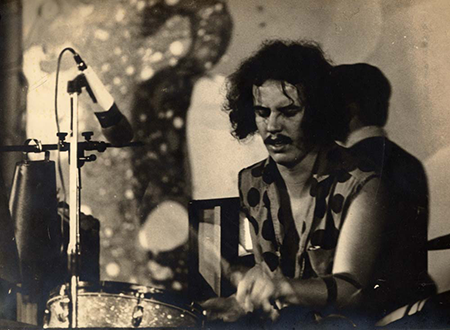
The first percussionist Zappa hired to tour with the Mothers of Invention was Arthur Dyer Tripp III (b. 1944), who brought an extensive background in classical and jazz percussion to the ensemble. Tripp grew up in Pittsburgh, where he received early percussion training from Stanley Leonard, timpanist with the Pittsburgh Symphony Orchestra. Tripp majored in percussion at the Cincinnati College-Conservatory of Music, studying with Cincinnati Symphony Orchestra percussionist Edward Weubold, and his experience included six months working with Composer-in-Residence John Cage.8 Tripp played with the Cincinnati Symphony, the Cincinnati Opera, the Cincinnati Pops, and the Dayton Philharmonic before moving to New York to study with Fred Hinger at the Manhattan School of Music.9
While in New York, he became the timpanist with the MSM orchestra, played in Paul Price’s percussion ensemble, taught percussion at Brooklyn Community College, and tutored private students at his residence. Tripp came to Zappa’s attention in early 1968 while the Mothers of Invention were in the process of recording Cruisin’ with Ruben and the Jets (1968) and Uncle Meat (1969) at Apostolic Studios in New York City, with Tripp ultimately sharing drumset credits on those albums with Jimmy Carl Black. When the Mothers relocated back to Los Angeles later in 1968, Tripp joined them, remaining with the band until late 1969 when Zappa disbanded the original Mothers of Invention in favor of a short-lived “power quartet” that included Zappa, Tripp, Ian Underwood, and Jeff Simmons.10

During Tripp’s time in the Mothers of Invention, Zappa showed a desire to further integrate percussive sounds and textures into his compositions. Tripp’s background both in classical music and jazz made him an ideal performer for bringing Zappa’s ideas to fruition. Selected tracks from Uncle Meat such as “The Dog Breath Variations,” “The Uncle Meat Variations,” the first section of “Project X,” and “Sakuji’s March” showcase dense layers of tightly-woven mallet lines with Tripp recording on vibraphone in tandem with Ruth Komanoff on marimba.11 “The Eric Dolphy Memorial Barbecue” from Weasels Ripped My Flesh (1970) and Zappa’s arrangements of “Wedding Dress Song” and “Handsome Cabin Boy” utilize layered mallet percussion overdubs performed by Tripp alone. Tripp’s live setup is shown in Example 1.
Tripp also spent many hours in the studio recording improvisations using a circular setup that included five brake drums, boo-bams, marimba, temple blocks, and several other instruments. The setup was inspired by Karlheinz Stockhausen’s “Zyklus” (1959), which Tripp had played as part of his undergraduate degree recital in 1966.13 These improvisations appear on several tracks from the Uncle Meat sessions such as “Nine Types of Industrial Pollution,” “Shoot You Percussion Item,” and “Enigmas 1 Thru 5.”14
Zappa’s own compositional influences are also obvious in his writing during this period. “The Uncle Meat Variations” contains a rhythmic accompaniment of low drum and tambourine that explores many permutations of the piece’s 3/4 time signature in a manner reminiscent of Stravinsky or Bartók, and the brief “Igor’s Boogie, Phase One” is clearly modeled on Stravinsky’s L’Histoire Du Soldat (1918). Another technique Zappa began using at this time was the unison doubling of mallet parts with non-melodic percussion instruments such as bongos or snare drum, as heard on “Uncle Meat: Main Title Theme.” These layering and overdub techniques gave Zappa a variety of options for creating “meta-mallet” textures when desired. Table 1 details our suggested listening for Art Tripp.
Following the release of Zappa’s 1969 solo jazz-fusion album Hot Rats and the subsequent disbanding of the original Mothers of Invention, Zappa spent the next several years working with a series of revamped Mothers lineups that included Aynsley Dunbar on drumset but no percussionist. Zappa’s most percussion-centric offering during this period is the improvisation “The Clap,” in which Zappa plays a drumset track and then overdubs improvisations on boo-bams, woodblocks, and other drums. A 90-second edit of this recording was released on Chunga’s Revenge (1970), with the complete unedited tracks appearing on Funky Nothingness in 2023.
At the conclusion of a show at London’s Rainbow Theatre on December 10, 1971, Zappa was attacked on stage by an angry fan, suffering serious injuries that forced him to spend much of 1972 confined to a wheelchair. He continued to produce during his recovery, focusing his energies on composing and recording Waka/Jawaka and The Grand Wazoo, two large-ensemble jazz-fusion albums that expanded on the Hot Rats concept.
Table 1: Art Tripp Recommended Listening
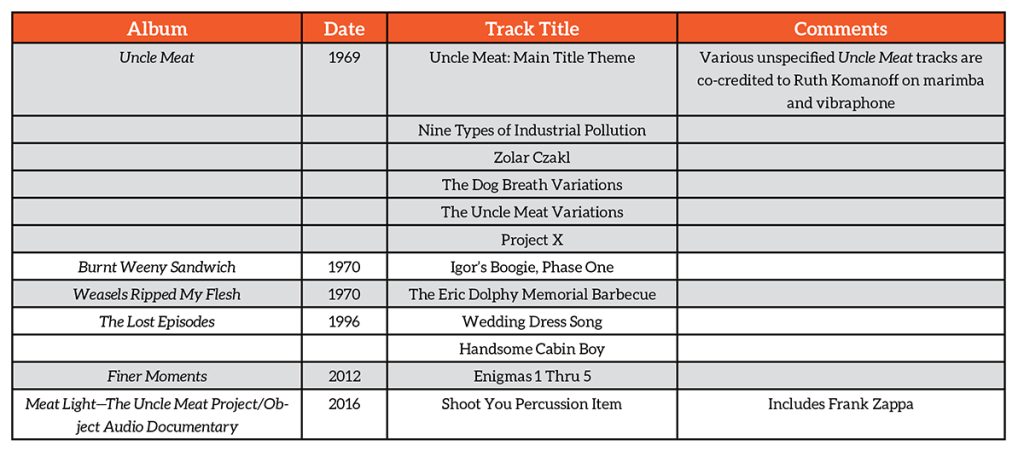
“LADIES AND GENTLEMEN, WATCH RUTH!”15
His injuries and initial forays into jazz-fusion now behind him, Zappa returned to the rock genre with a new ensemble that remained largely intact from February 1973 until December 1974. It has been suggested that touring with the Mahavishnu Orchestra in Spring 1973 is partially responsible for the noticeable shift in Zappa’s musical language during this period, as he sought to meld the precision and virtuosity of art-music composition with the timbres and visceral power of the rock ensemble.16 This era of Zappa’s career features one of his most well-regarded ensembles and resulted in some of his earliest breakthrough mainstream success due to the complex but accessible musical language. One of the cornerstones of this highly touted lineup was percussionist Ruth Komanoff Underwood (b. 1946).

Photo courtesy of Ruth Underwood
Raised on Long Island, New York, in the town of Long Beach, Ruth Komanoff studied piano from age four through her high school years. During her senior year, she took her first and only lessons on marimba from Ithaca College alumnus Glenn E. Brown, Music Supervisor for the Long Beach Public Schools and marimba soloist with Xavier Cugat’s Orchestra. Komanoff enrolled at Ithaca College in 1962 as a piano major, switching to percussion in her sophomore year and studying with Warren Benson. She left Ithaca to attend the Juilliard School in 1965, studying there with Saul Goodman and Morris Goldenberg, earning her BA in Percussion in 1967, and continuing on to pursue a master’s degree.17 While at Juilliard, she played drumset in the Hamilton Face Band with her friend and colleague Steve Margoshes, recording a self-titled album in 1969 and Ain’t Got No Time in 1970.
Komanoff was first exposed to the Mothers of Invention during their six-month residency at New York City’s Garrick Theatre in 1967. Drawn to Zappa’s musical language and the absurdist performance art of the Garrick shows, she became an audience fixture. After introducing herself to Zappa, he invited her to participate as an opening act for the Mothers for two shows at Town Hall (December 22–23, 1967). This was the first time Zappa heard Komanoff play the marimba and, impressed by what he heard and saw, he called her about six weeks later to participate in two nights of recording for the Uncle Meat overdub sessions with Art Tripp at Apostolic Studios in early 1968.
Following her 1969 marriage to Mothers of Invention reed and keyboard player Ian Underwood and several credits shy of earning her master’s degree, Ruth relocated to Los Angeles. Once there, she played a tailor-written orchestra drumset part for Zappa’s surrealistic road-diary movie 200 Motels (1971) and performed alongside Tom Raney as one of the percussionists for the 1972 Grand Wazoo tour.
Well-known for encouraging the unique talents of his players, Zappa expanded the role of the percussionist in his music beginning with Over-Nite Sensation (1973). Underwood recalls: “Many of the parts that Frank wrote for me just suited me perfectly. It’s the music I would have written for myself if I had had that talent. And Frank knew how to do that for me. I think he knew how to do that for, really, everybody.”18
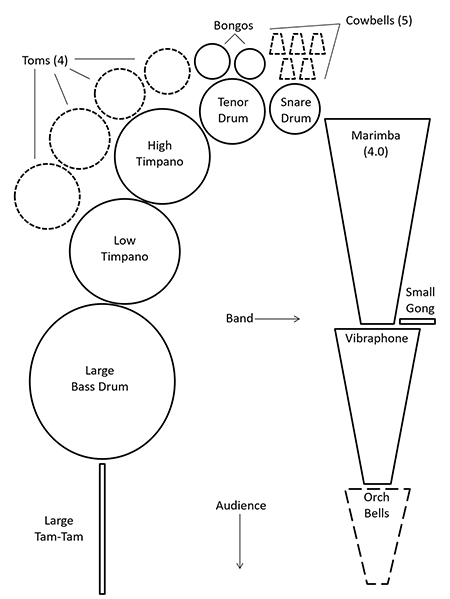
At the risk of oversimplifying the diversity of Zappa’s palette over the course of a life and career, AD Amorosi remarks that: “Once part of the family, hers was his most prominent tone. Save for his searing, inventive guitar work and droll vocals, Ruth Underwood is the defining sound within the Zappa oeuvre: the revolutionary necessity of percussive foregrounding and its integrated melodic overdrive borrowed from Zappa’s hero, the avant-garde composer Edgard Varèse…Underwood discusses the relief that she recalled, having a composer recognize the potentially artful impact of melodic mallet percussion, and how that could move such instrumentation beyond the orchestra’s small-minded vision…or its cartoon theatricality.”19
With Underwood in the lineup, Zappa brought concert percussion to the forefront of his musical ideas in the rock genre, no longer relegating percussion to coloristic textures in the controlled studio environment or limiting its use onstage to occasional sound effects played by various band members. The inclusion of a dedicated percussionist would become a central feature of Zappa’s ensembles through the rest of his recording and touring career.
Underwood, like Tripp before her, served as both mallet player and multi-percussionist, employing a sizable range of instruments. Underwood’s setup is prominently visible in the concert videos compiling footage filmed during her time in the ensemble. Roxy–The Movie (2015) was recorded during the run of performances held at Hollywood’s Roxy Theater in December 1973, while A Token of His Extreme (1976/2013) and The Dub Room Special (1982/2005) both draw from the August 27, 1974 KCET Special Concert in Los Angeles. Example 2 details Underwood’s core setup plus specific additions made for the Roxy and KCET performances.
The logistics of touring with a full array of percussion instruments and adequately amplifying them to balance with electric instruments were significant considerations for Zappa. Underwood describes the process of amplifying the mallet instruments: “We had no instruments that could compete with electric instruments. There were no such things as electric marimbas. I was able to get tremendous satisfaction from doing some recording with him. But the idea of traveling, of being a member of the band, was something that seemed completely out of reach, for so many reasons, not the least of which was that we didn’t have the technology for it. And then one day, he said to me, ‘You know, you could make your marimba electric.’ He described to me about Barcus-Berry and transducers, and I thought ‘Well, this sounds just wonderful,’ and then he said, ‘What they do is, they drill into each bar.’ As soon as he said ‘drill,’ you’d be drilling into my body because I owned at that time one marimba — the one that I’d had since I was 16 years old. And to drill into that — that was just not going to happen! But Frank was so clever. He said, ‘I’ll get my vibraphone done if you get your marimba done.’ And I thought, ‘If he’s going to take a chance with his vibraphone,’ and I knew he’d had that for a long time, ‘I’ll do it.’ And so we were able to travel with those instruments. It was extraordinary! I’ll never forget the day that we plugged it in for the first time. Frank handed me a mallet and said, ‘Okay.’ I just went like that [imitates stroke], and it was deafeningly loud! He looked positively gleeful. He looked almost maniacal, like, ‘Now I can rule the world! I’ve got all the percussion at my disposal!’”20
Underwood notes that the Barcus-Berry transducer systems used for her Musser M30 Brentwood marimba and Zappa’s Deagan Commander vibraphone were tailored for quadraphonic sound, and live footage shows her playing both instruments without resonators, rendered unnecessary due to the electronic amplification.21 Later in her tenure, Underwood also toured with the first Musser Kelon synthetic-keyed marimba to be outfitted with the transducer setup.22
Zappa used mallet instruments to fill standard roles in the rock ensemble, typically doubling guitar or keyboard lines, playing ostinato riffs, and providing melodic fills. Arved Ashby attributes Zappa’s use of mallet doubling at least partially to its prevalence in so-called “lounge music” made in the post-WWII years, specifically singling out the work of arranger Les Baxter.23 Zappa’s own interpretation of this style can be heard in the commercially saturated production of tracks on Sleep Dirt (1979). Zappa would often use mallets prominently in the opening and closing sections of a composition, and Underwood would then drop out during extended solos. Excellent examples of this approach can be found on “RDNZL,” “Big Swifty,” and “Inca Roads,” one of Zappa’s acknowledged masterworks.
Underwood’s virtuosity allowed Zappa to write intricate lines on marimba and vibraphone, often in unison or counterpoint with keyboardist George Duke. A particularly notable example of this is the 32-bar “Rollo Interior” mallet/keyboard feature included as the central section of “St. Alfonzo’s Pancake Breakfast” from apostrophe (’) (1974).24 Underwood has remarked on both the fantastic stereo effect of her mallet percussion on one side of the stage coupled with Duke’s synthesizers on the other, as well as Zappa’s interest in her acoustic instruments’ ability to emphasize the character of melodic lines by accenting notes in ways that were not possible on the synthesizers.25 Underwood’s skill also allowed Zappa to use the mallet instruments as the primary melodic timbre in his writing instead of or in addition to guitar and keyboards, subverting typical norms in the rock genre. On “The Dog Breath Variations/Uncle Meat” from A Token of His Extreme, Underwood carries the primary melodic material through the majority of the four-minute composition. This track is also a prime example of Zappa’s continued use of the “meta-mallet instrument” concept, as he doubles the melodic line on untuned percussion through much of the composition, performing the part himself from within Underwood’s setup.28
The virtuosity of the 1973–74 band allowed Zappa to further develop his compositional skill, resulting in high-quality performances of pieces that move his ensembles into the realm of progressive rock, containing angular and very difficult unison melodic lines, frequent tempo changes, and complex metric schemes.29 The various releases drawn from the Roxy shows contain such noteworthy examples as “T’Mershi Duween,” “Echidna’s Arf (Of You),” and “Cheepnis-Percussion,” a showcase during which Zappa featured his entire percussion section by having Underwood and dual drumset players Ralph Humphrey and Chester Thompson play their parts absent the other instrumental and vocal material. Table 2 shows our suggested listening for Ruth Underwood.
Possibly the most well-known example of Underwood’s playing is the performance of “The Black Page Drum Solo/The Black Page #1” recorded live at The Palladium in New York City in December 1976 with Terry Bozzio on drumset, Dave Samuels on vibraphone/percussion, and Underwood on marimba/percussion. During the live performance, Bozzio plays the famously intricate composition as a drumset solo, which is then doubled note-for-note on keyboard percussion. Post-production overdubs were added in March 1977 by Underwood, Ed Mann, and John Bergamo,30 and the piece was included on Zappa In New York (1977) in two different arrangements. While “The Black Page #2” would go on to become a concert staple in its various permutations for the rest of Zappa’s career, “The Black Page #1” is notable in that it marks Underwood’s final performances with Zappa as well as Ed Mann’s first.31
Table 2: Ruth Underwood Recommended Listening
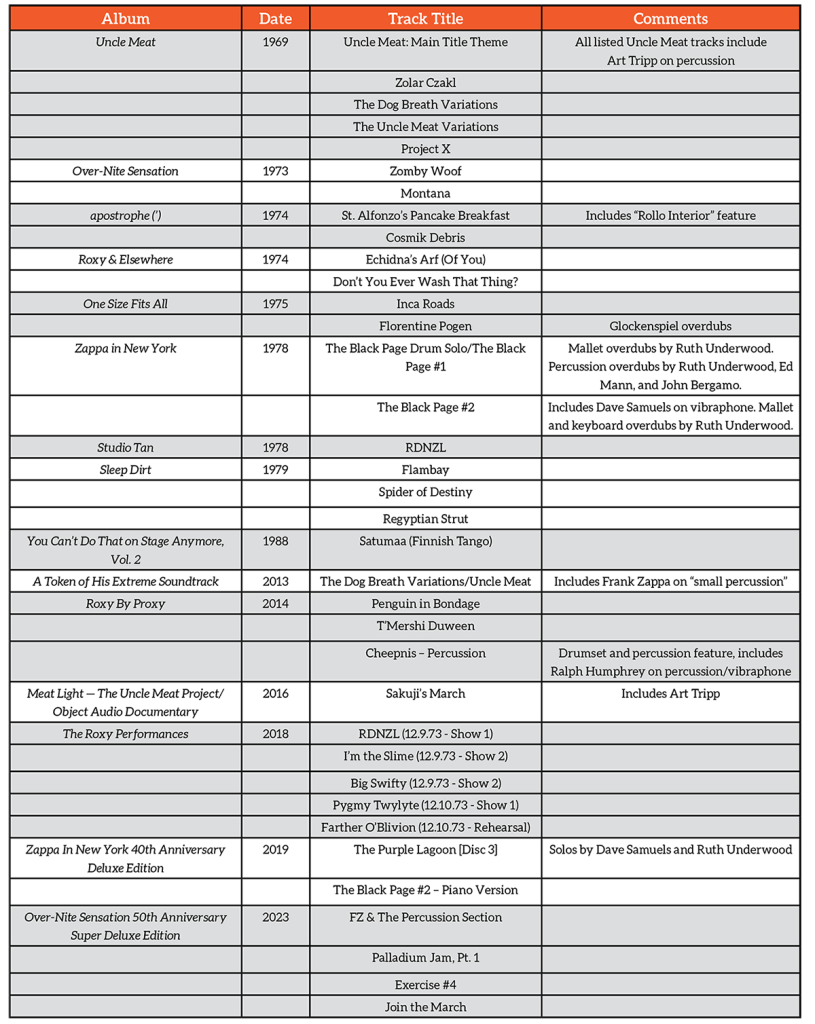
“ED MANN HAS BEEN WORKING ON THIS LITTLE LICK ALL AFTERNOON”32
Ed Mann (b. 1955) was born in Philadelphia and grew up in Pennsylvania, New Jersey, and Massachusetts. He studied with Alexander Lepak at the Hartt School of Music for several years, and later studied with John Bergamo at the California Institute for the Arts.33 Mann became Zappa’s full-time percussionist in 1977, a position he would hold through the end of Zappa’s touring career in 1988. Due to the immense amount of live and studio material Zappa recorded during those years, Mann appears on more of Zappa’s releases than any other musician except Zappa himself.
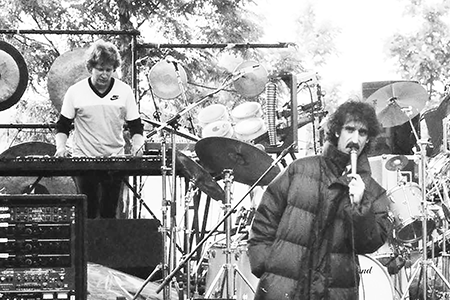
Not intended to merely replace Ruth Underwood in the band, Mann recalls Zappa defining his job description this way: “I want you to just be yourself. You can hear the music. Learn the lines, but experiment. Reharmonize, orchestrate, add parts, subtract parts, if you get a weird idea don’t look to me for approval, just do it. If I don’t like it, I’ll tell you, but I want you to learn my compositional vocabulary and then experiment with it. I want you to play some but not all sections exactly as I write them, and I want you to solo. If I point to you, just solo. I don’t care if it’s good or bad, just do it. Most of all, take an experimental approach.”34
Mann’s skill set allowed Zappa to retain the functions of mallets and percussion in his live ensembles while simultaneously capitalizing on cutting-edge recording and studio technologies, perfecting the techniques he’d previously used so successfully with Tripp and Underwood. Zappa could create the sense of having an entire mallet section at his disposal by having Mann overdub mallet parts in the studio using combinations of marimba, vibraphone, xylophone, glockenspiel, and chimes, in addition to various gongs and other percussion. Examples of these mallet choirs include the Baroque-flavored blues progression in the middle of “The Central Scrutinizer,” the angular interlude of “Fembot In A Wet T-Shirt,” the crystalline beauty of the interlude in “Packard Goose,” the pop sensibilities of “We Are Not Alone,” “We’re Turning Again,” and “Sharleena,” the operatic hard rock of “Teenage Prostitute,” and the complex polyrhythms of “Moggio,” “Alien Orifice,” and the final section of “Sinister Footwear II.”
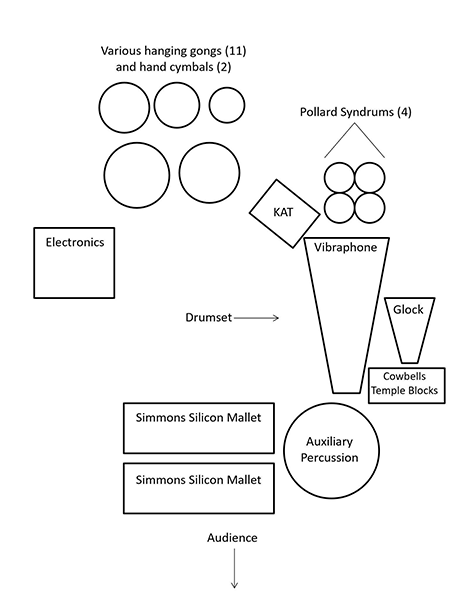
Mann was equally capable as a live performer and was tasked with performing the virtuosic percussion and mallet parts made famous by his predecessors, especially apparent in the expanded “Don’t Eat the Yellow Snow” suite featured on You Can’t Do That On Stage Anymore, Volume 1 (1988), and in numerous examples from Zappa’s final tour in 1988 including the “Let’s Make the Water Turn Black/Harry, You’re a Beast/The Orange County Lumber Truck” medley and “Strictly Genteel” on Make a Jazz Noise Here (1988). In a 1990 interview published in Modern Drummer, Rick Mattingly remarked: “I don’t know if Zappa is the kind of guy who pays extra for ‘doubling,’ but with Ed Mann, he’s getting about three players’ worth of percussion in one person.”35 Mann was also occasionally featured as a soloist in “Pound for a Brown,” as captured on Hammersmith Odeon (2010), in which he takes an extended vibraphone solo over the piece’s 7/4 vamp. In most of Zappa’s late-1970s live tours and throughout the 1980s, Zappa would take several lengthy guitar solos over the course of a concert, with backing vamps consisting of just one or two alternating chords. Mann’s orchestration was often a vital component of these backing vamps, as can be heard on “Watermelon in Easter Hay,” “The Deathless Horsie,” “Outside Now,” and “Twenty-One.”
All touring percussionists must simultaneously contend with the ambitions of the composer and performer as well as the practicalities of being on the road. Like Zappa, Mann was an enthusiastic adopter of emerging technologies, incorporating digital drums and early digital mallet instruments such as the Simmons Silicon Mallet, greatly increasing the versatility of his setup and allowing him to readily access extensive libraries of sampled sounds.36 Examples of Mann’s various digital keyboard sounds and sound effects can be heard on “Bolero,” “Stairway to Heaven,” “The Orange County Lumber Truck,” and “Rhymin’ Man,” all recorded during the 1988 tour. “Rhymin’ Man,” a cowboy-country pastiche lampooning Reverend Jesse Jackson’s unsuccessful bid for the 1988 Democratic presidential nomination, is also notable for its abundant pop-culture musical references, with Mann’s melodic and percussive fills alluding to various topics in the lyrics.37 Example 3 diagrams Mann’s setup for the 1988 tour.38
As Zappa’s compositions in the late 1970s and ’80s became increasingly complex and disjunct, he would often juxtapose sections of widely varying styles against each other in quick succession. Pieces of this nature are particularly interesting as they certainly owe their compositional influence to art music, while their timbres and orchestrations situate them firmly in the rock genre. The progressive rock/’80s power-ballad contrast of “What’s New in Baltimore?,” the poly-stylistic “Drowning Witch,” the Halloween-ish kitsch of “Envelopes,” as well as other pieces mentioned above, were all performed and recorded live and then augmented in the studio as needed. Mann’s superlative keyboard and percussion work plays a central role in all of these pieces.
Perhaps no single recording better demonstrates Mann’s skill and versatility than the “Theme from the 3rd Movement of Sinister Footwear,” from You Are What You Is (1981). The sequence of steps required to create this track is well-known among enthusiasts and is a perfect example of xenochrony, one of Zappa’s signature compositional techniques. The basic track was a performance of Zappa’s concert-opening improvisation “Persona Non Grata” from the Palladium in New York City on Oct. 27, 1978.39 Zappa extracted the guitar solo from the recording and requested that guitarist Steve Vai transcribe the solo in its entirety.40 Vai, Mann, and bass clarinetist David Ocker then recorded overdubs in unison with the original improvisation, with Mann employing a combination of marimba, glockenspiel, woodblocks, and cowbells. Finally, Zappa edited and superimposed the guitar solo and overdubs onto an entirely unrelated rhythm track recorded in 1980 or 1981, thus completely redefining the tempo and metric context of the original solo. The final product is breathtaking in its complexity and precision, with Mann’s mallet work at the fore. Our suggested listening for Ed Mann is presented in Table 3.
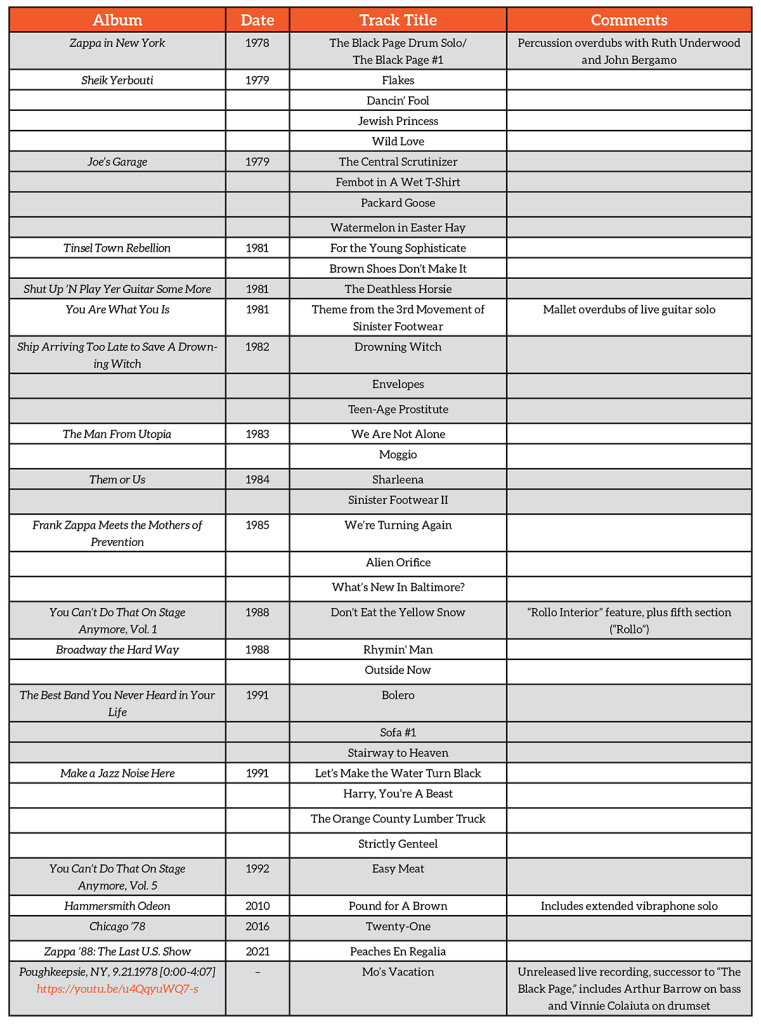
“YES & BUT ALSO”41
Frank Zappa ceased touring in 1988, making only very sporadic public appearances thereafter while continuing to release records at a prodigious rate.42 After several years of declining health, he succumbed to prostate cancer in December 1993. The Yellow Shark (1993), his final album release, was recorded in collaboration with the Ensemble Modern and secured Zappa’s legacy as a legitimate art-music composer. The album prominently features percussion throughout, with “The Girl in the Magnesium Dress” being particularly noteworthy.
After leaving the Mothers of Invention “power quartet” in 1970, Art Tripp spent several years playing drumset and marimba with Captain Beefheart & The Magic Band,43 as well as playing on several additional records by other members of Zappa’s musical circle including Larry “Wild Man” Fischer, Jean-Luc Ponty, and Jefferson Airplane. Tripp’s critical accolades in Jazz & Pop magazine during his time with Zappa include placing second in the 1969 Critic’s Poll in the Vibraphone-Pop category behind Gary Burton and placing third in the Vibraphone category of the 1970 Reader’s Poll behind Burton and Roy Ayers. He left the music business in 1978 and has been a practicing chiropractor since that time.
Ruth Underwood performed as a session musician for George Duke, Billy Cobham, and others through the remainder of the 1970s and into the early ’80s. She also gave private lessons in mallets, piano, and music theory, taught volunteer classes in music appreciation, percussion-instrument crafting, and music arranging at the schools of her two children (now both successful academics and musicians), and explored other life-long creative passions. In June 1993, just months before his passing, Zappa arranged to have Underwood come to his home for several days to record and sample her instruments. She has been a regular contributor to Zappa Family Trust activities since 2014, authoring numerous liner notes for Vault releases, appearing throughout Alex Winter’s 2020 Zappa documentary, and playing a poignant solo piano rendition of “The Black Page” that was included on the Zappa In New York 40th Anniversary Deluxe Edition (2019).
Ed Mann has cultivated a vibrant and ongoing career performing as a bandleader/solo artist,44 as a member of the Repercussion Unit, and as a sideman/session musician for innumerable artists and on Hollywood soundtracks. He has also been a faculty member at CalArts, worked as a sound designer for Simmons and E-mu, served as a gong specialist for Paiste and UFiP, and used gong and sound work in the practice of holistic medicine.
Historically, print-music editions of Zappa’s music have proven difficult to obtain, short of renting official performance materials or locating the occasional Zappa score in a university library’s special collections. Mass-market releases of Zappa’s music began with The Frank Zappa Songbook, Volume 1 (1973) and The Frank Zappa Guitar Book (1982), followed in recent years by authorized transcription books covering Hot Rats, Over-Nite Sensation, apostrophe (’), and One Size Fits All. All of these books are marketed towards and arranged primarily for guitar players, but do represent a sampling of Zappa’s compositional language in standard and tablature notation. With some adaptation, these sources can provide a foundation for aspiring percussionists to explore some of Zappa’s more notable mallet material, particularly during Ruth Underwood’s tenure. The Zappa catalog is rewarding in a myriad of ways, offering exemplary opportunities for music theory analysis, technical study, sight-reading, and alternative material for excerpt practice. The singular compositional voice and aspirations of Frank Zappa provide percussionists with an opportunity to simultaneously explore contemporary compositional techniques and the rich history and diversity of American popular music.
ENDNOTES
1. “The Poodle Lecture,” You Can’t Do That on Stage Anymore, Vol. 6 (1992).
2. Though drumset has been a part of the sonic fabric of rock music since its formation, non-drumset percussion has also been present from the onset of the style, including emphasizing the backbeat with tambourine and handclaps, using vibraphone to provide melodic and harmonic color, and enhancing songs through the addition of other sound colors.
3. For more information about the specific recording details of each album, refer to Ulrich, 2018 and to Román García Albertos’ website “Information Is Not Knowledge,” which presents exhaustive information on Zappa’s entire catalog, compiled from a wide variety of print and online sources.
4. Andreyev, 2020, [5:30–5:45].
5. Zappa, 1989, pp. 68–78.
6. Robertson, 1978, p. 17. Zappa remarks that “the hypophone is [Kim Fowley’s] mouth, ‘cause all that ever comes out of it is hype.”
7. Ulrich, 2018, pp. 165–173.
8. Andreyev, 2020, [1:50–3:40].
9. Ulrich, 2018, pp. 556–557.
10. Tripp, August 2022.
11. Tripp, September 2022.
12. Tripp, August 2022.
13. Andreyev, 2020, [19:45–22:40].
14. Tripp also recorded improvisations during these sessions that would later appear on the Zappa-produced An Evening with Wild Man Fischer (1969), featuring Hollywood busker and street personality Larry “Wild Man” Fischer.
15. “Don’t You Ever Wash That Thing?,” Roxy & Elsewhere (1974).
16. Bozzio et al, 2009, [12:25–20:30] and the Halloween 73 (2019) liner notes include additional commentary by both Ralph Humphrey and Underwood on this point.
17. Wagner, 2005, pp. 38, 41, and 358; Ulrich, 2018, pp. 374–375.
18. Longfellow, 2007, 32:07–32:20
19. Amorosi, 2021. Emphasis in original.
20. Longfellow, 2007, “Transduce That Marimba” Bonus Feature, [23:15–25:50].
21. Underwood, November 2022.
22. Bozzio et al, 2009, [49:52–51:50].
23. Ashby, 1999, p. 587.
24. Longfellow, 2007, [30:10–35:15] discusses “St. Alfonzo’s Pancake Breakfast” and Howard, 2019, [11:54–22:04] provides an in-depth analysis of “Rollo Interior.”
25. Amorosi, 2021 and Underwood’s liner notes for Roxy By Proxy (2014) discuss both of these elements in depth.
26. It is perhaps indicative of Zappa’s priorities that in his list of the orchestral musicians hired for the Royce Hall engagement, the four percussionists are listed first.
27. Ulrich, 2018, pp. 487–490.
28. Underwood, November 2022. According to Underwood, Zappa referred to this section of the setup as the “small percussion.” Zappa can also be heard improvising in this setup with Underwood and drumset player Ralph Humphrey on “FZ & The Percussion Section” and “Palladium Jam, Pt. 1” from the Over-Nite Sensation 50th Anniversary Super Deluxe Edition (2023).
29. Zappa rigorously rehearsed his ensembles prior to touring, and song arrangements could change between shows or exist in multiple simultaneous versions, sometimes switching on cue in the midst of a live performance. Nevertheless, from the earliest days of the Mothers of Invention, Zappa always expected the musicians to perform onstage with the entire repertoire memorized.
30. Mann, July 2021.
31. Borders, 2000 provides a complete analysis of the various arrangements of “The Black Page.”
32. “Don’t Eat the Yellow Snow,” You Can’t Do That on Stage Anymore, Vol. 1 (1988).
33. Ulrich, 2018, pp. 332–333.
34. Mann, July 2021 and July 2022.
35. Mattingly, 1990, pg. 19.
36. Mattingly, 1990 provides detailed explanations of Mann’s capabilities and process.
37. Smith, 1995 describes the content and context of these references in detail.
38. Mattingly, 1990 provides more in-depth specifics of Mann’s 1988 tour setup.
39. An official recording of this performance has never been released, but has circulated widely in the Zappa bootleg circuit. It is accessible at https://youtu.be/CUFFTWse7Wo?si=Clnw2BKwiU55aRm3
40. The Frank Zappa Guitar Book (1982) includes Vai’s transcription of the complete unedited solo.
41. Roxy–The Movie (2015) menu screen.
42. Greenaway, 2010 includes perspectives on the financial and interpersonal circumstances that caused Zappa to cut the 1988 tour short.
43. Tripp appeared on five Captain Beefheart albums released between 1970 and 1978. His most substantial contributions appear on Lick My Decals Off, Baby (1970) and The Spotlight Kid (1971).
44. Mann’s solo albums Get Up (1988) and Perfect World (1990) have been particularly well-received by critics and players alike.
BIBLIOGRAPHY
Albarian, John, director. Roxy–The Movie. Zappa Family Trust, 2015.
Albertos, Román García. “Information is Not Knowledge.” 1998, www.donlope.net/fz/
Amorosi, A.D. “Of Motels and Mallets.” Wax Poetics, November 30, 2021. https://www.waxpoetics.com/article/frank-zappa-surrealistic-masterpiece-200-motels/
Andreyev, Samuel. “Art Tripp on Working with Frank Zappa, John Cage, and Captain Beefheart.” YouTube, April 24, 2020, www.youtube.com/watch?v=ugMep20elgQ
Ashby, Arved. “Frank Zappa and the Anti-Fetishist Orchestra.” The Musical Quarterly, Vol. 83, No. 4, Winter 1999, pp. 557–606.
Bernard, Jonathan. “Listening to Zappa.” Contemporary Music Review 18, no. 4, 2000, pp. 63–103.
—. “The Musical World(s?) of Frank Zappa: Some Observations of His ‘Crossover’ Pieces.” Expression in Pop-Rock Music: A Collection of Critical and Analytical Essays, ed. Walter Everett, New York: Garland, 2000, pp. 157–210.
Borders, James. “Frank Zappa’s ‘The Black Page’: A Case of Musical ‘Conceptual Continuity’.” Expression in Pop-Rock Music: A Collection of Critical and Analytical Essays, ed. Walter Everett, New York: Garland, 2000, pp 137–156.
Bozzio, Terry, et al. Drummers of Frank Zappa: Roundtable Discussion and Performance. DrumChannel.com, 2009.
Courrier, Kevin. Dangerous Kitchen: The Subversive World of Zappa. Toronto: ECW Press, 2002.
Darley, Dick, director. A Token of His Extreme. Zappa Family Trust, 1976/2013.
Gossard, Jason. “We’re Only In It for the Touring.” 2009, fzpomd.net/turtlestew/index.htm
Greenaway, Andrew. Zappa The Hard Way. Bedford, England: Wyman Publishing, 2010.
Howard, Samuel. “How Did Frank Zappa Write Melodies? (Rollo Interior and RDNZL Analysis).” YouTube, April 16, 2019, www.youtube.com/watch?v=suCYxcq1h7o
Jackson, Michael, creator. “Frank Zappa.” The Late Show. BBC2, March 11, 1993.
Jensen, Ingrid Marie. “Ruth Underwood: A Mother of Invention.” 2021, pleasekillme.com/ruth-underwood/
Kaszuba, Bartek. “Frank Zappa – Stockholm 1973 08 21 (full concert).” YouTube, June 12, 2012, https://youtu.be/BynKe8BjIxk?si=NVDK7WfJytSJTSyS.
Longfellow, Matthew, director. Classic Albums: apostrophe (’)/Over-Nite Sensation. Her Majesty, the Scarlet Pimpernal, 2007.
Lowe, Kelly Fisher. The Words and Music of Frank Zappa. Lincoln: University of Nebraska Press, 2007.
Mann, Ed. “Hired by Frank Zappa.” July 2021, web.archive.org/web/20210729225850/https://gonzotoday.com/2021/07/29/hired-by-frank-zappa/
—. “Hired by Frank Zappa – Chapter 2: The First Week.” August 2021, web.archive.org/web/20210817132059/https://gonzotoday.com/2021/08/17/hired-by-frank-zappa-chapter-2-the-first-week/
Mann, Ed. Personal communication, July 28, 2022.
Mattingly, Rick. “Ed Mann.” Modern Drummer, Vol 14, No 1, January 1990, pp. 18–23, 52–59.
Prism Films. “Zappa & MOI: Art Tripp.” YouTube, June 26, 2012, www.youtube.com/playlist?list=PL28685C64CDB501C5
Robertson, Sandy. “Zappa Digs Sabs Shock!” Soundings, January 28, 1978, pp.17, 24. https://www.afka.net/Articles/1978-01_Sounds.htm.
Sloots, Kasper. “Frank Zappa’s Musical Language.” 2000, www.zappa-analysis.com/
Smith, Christopher. “Broadway the Hard Way: Techniques of Allusion in the Music of Frank Zappa.” College Music Symposium 35, 1995, pp. 34–60.
Sovetov, Vladimir. “ARF: The Home of Frank Zappa Heritage Studies.” 1996, www.arf.ru/
Tripp, Arthur. Personal communication, August 2, 2022.
—. Personal communication, September 19, 2022.
—. “Traditional Chiropractic.” 2013, traditionalchiropractic.com/
Ulrich, Charles. The Big Note: A Guide to the Recordings of Frank Zappa. Vancouver: New Star Books, 2018.
—. “The Planet of My Dreams.” 2012, fzpomd.net/index.html
Underwood, Ruth. Personal communication, November 1, 2022.
—. Personal communication, March 23, 2023.
Van Laarhoven, Peter. “United Mutations.” 2002, www.united-mutations.com/
Wagner, Alan D. A Bio-Bibliography of Composer Warren Benson. Lewiston, NY: Edwin Mellen Press, 2005.
Winter, Alex, director. Zappa. Roxbourne Media Limited, 2020.
YourArf. “Frank Zappa – Persona Non Grata – 1978, NYC (audio).” YouTube, 2011, www.youtube.com/watch?v=CUFFTWse7Wo
Zappa Family Trust. “Zappa.com Official Discography.” 1993-2016, www.zappa.com/music/official
Zappa, Frank. apostrophe (’) Guitar Recorded Versions. Milwaukee: Hal Leonard Corporation, 2003.
—. Halloween 73 Liner Notes. Zappa Records, 2019.
—. One Size Fits All Guitar Recorded Versions. Milwaukee: Hal Leonard Corporation, 2011.
—. Over-Nite Sensation Guitar Recorded Versions. Milwaukee: Hal Leonard Corporation, 2010.
—. Roxy By Proxy Liner Notes. Zappa Records, 2014.
Zappa, Frank, with Peter Occhiogrosso. The Real Frank Zappa Book. New York: Touchstone, 1989.
Dr. Kyle Forsthoff is the Artist/Teacher in Classical Percussion at the University of Rhode Island, the President of the Rhode Island PAS Chapter, and an Associate Editor of Percussive Notes. He is an active performer, educator, and scholar in both Fife & Drum and Irish Traditional Music and is the percussionist for Fellswater and the Island Time Steel Band.
Dr. Michael Yonchak is an Associate Professor of Music at Otterbein University in Westerville, Ohio, where he conducts the wind ensemble, oversees the band area and percussion studio, and teaches courses focused on popular music and culture. He is also a freelance percussionist in central Ohio, performing with the Flamenco Company of Columbus as well as a multitude of groups that cover the contemporary stylings of rock, jazz, and country.









